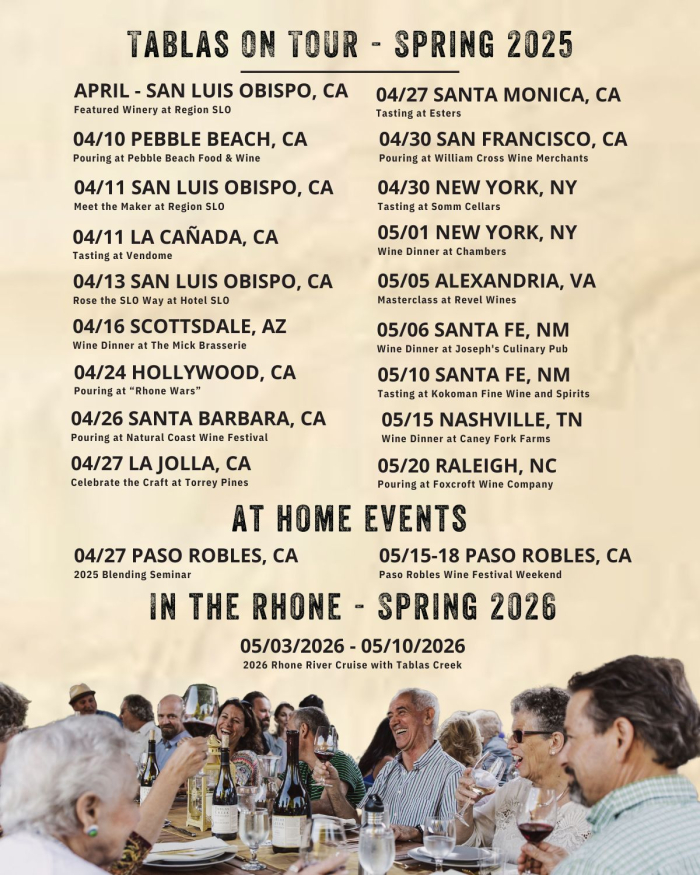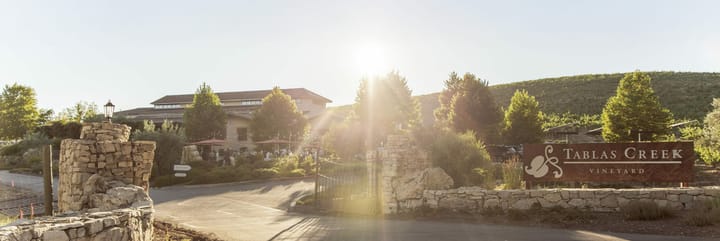Social media used to be a lousy way to promote wine events. Then we started thinking of it like we were a band on tour.
Last year I started thinking differently about one of the ways that we use social media at Tablas Creek.
What spurred it was my own effort to get out and see more live music now that our kids are getting older and are mobile on their own or out of the house. I realized as I started following more of my favorite bands on Instagram that one of the most useful types of posts was the tour update so I could see at a glance where they were going to be and when without having to go to their website and do the research.
So, we launched the #TablasOnTour series where we share where we’ll be the next 6-8 weeks every month. Here's the one we're sharing today:

It’s been fascinating to see the reach of these posts, which are typically double the reach of our standard social media posts diving into farming or winemaking, and roughly quadruple the reach of posts talking about any individual event we’ll be participating in. Diving into the analytics, it’s all because of shares: people seeing an event they might want to attend and sending the post to friends or family they’d want to go with. Those shares are further augmented by the partners we're coordinating the events with, who share the post to their audience. Beyond the eyeballs that see these shares, Instagram has prioritized shares and comments over views and likes, so these sorts of interactions encourage the algorithm to organically show the post to more people.
It's worth noting that posts on individual events are among our lowest-performing posts, to the point that we've just about stopped doing them. There are good reasons why these sorts of posts typically struggle to connect over social media. An event is an inherently participatory thing. Whatever the event is that you're promoting, the audience that is going to be interested is limited by geography, timing, and format. A wine dinner in Cincinnati, Miami, or San Francisco? Probably not appealing unless you live in that specific city. An event that already happened? Sure, some of the 80-or-so people who attended might chime in with how fun it was, but how many of those are going to see it on your social media? Not a lot, and it's hard to interest someone who didn't attend in an event that's already concluded. An upcoming blending seminar at the winery? Better, but still, most of the people you reach probably aren't going to be free on that afternoon. (Note: if you are free, our 2025 blending seminar is on Sunday, April 27th, and it's going to be super fun.)
Because these sorts of "on tour" posts aggregate the interest in each of the events that they list, they largely avoid the "only interesting to a small percentage of your audience" issue that drives down the success of individual event posts. What's more, they are visible, shareable gestures of support for the restaurants, wine shops, and organizations that are hosting us around the country. These posts build goodwill among our partners as well as driving interest and attendance at the events themselves.
Before we launched the #TablasOnTour series, we were mostly promoting the events we participated in via our email list. We would draw a radius around the event location and send out a geographically-targeted email to mailing list members within that radius. And we're continuing to do this. There's nothing like appearing in someone's inbox letting them know that you'll be in their neck of the woods. But geo-targeted emails aren't a perfect solution. Imagine a wine club member who will be on vacation near where we'll be hosting an event. There's no way we can know to send them an email. Or a friend who works for a local winery with friends or family in the event's location, who might be able to pass along news of something interesting happening. We are trying to avoid having all our promotional eggs in a single email basket.
What's more, if we're trying to attract younger wine lovers, we can't rely principally on email, as there's good data that while younger consumers all have email addresses, it's not how most of them prefer to receive information. Add that to the increasing push by email providers working to keep promotional emails out of their users' inboxes, and we know that emails are less likely than ever before to reach their target audience. Sharing the same information across multiple channels helps us know that the information is more likely to get to the audience who will want to see it.
This moment in wine feels like an important one to rethink how we promote events. All the wineries and wine organizations that I speak to share stories about how they're having to work harder to drive event attendance. But at the same time, getting out and showcasing your wines is one of the tried and true ways for a winery to promote itself. I know that we've never been working harder to take the Tablas Creek story on the road; we already have 26 events on our calendar between now and just the end of June. There are huge incentives for us to spread the word.
Until recently, social media wasn't helping this push much. Now it is.

